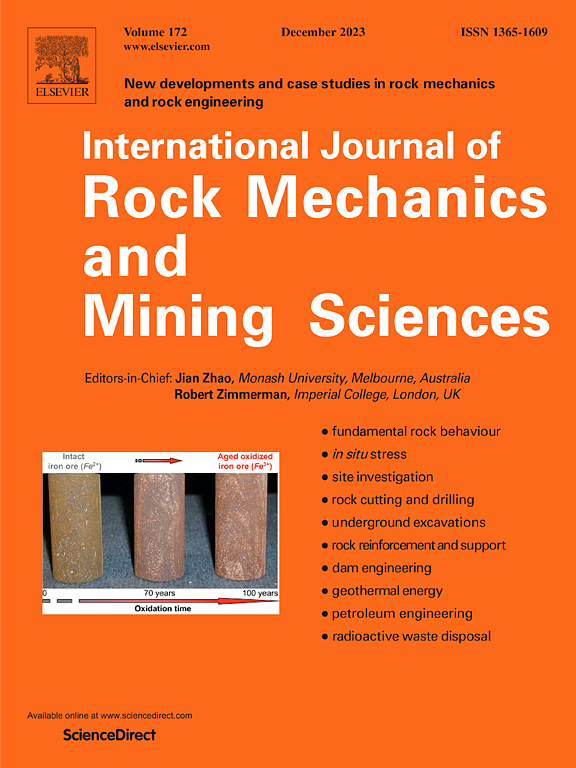Crack aperture and hydraulic conductivity tensors for cracked crystalline rock masses
IF 7
1区 工程技术
Q1 ENGINEERING, GEOLOGICAL
International Journal of Rock Mechanics and Mining Sciences
Pub Date : 2025-02-22
DOI:10.1016/j.ijrmms.2025.106058
引用次数: 0
Abstract
A hydraulic conductivity tensor for a cracked crystalline rock mass was formulated in closed form as a function of the following parameters: 1) the mean and standard deviation in a lognormal distribution of crack apertures, 2) the number of hydraulically conductive cracks intersected by a scanline per unit length and correction term depending on the scanline direction, 3) the fabric tensor determined by the statistical distribution of unit vectors normal to the crack surfaces, and 4) the in-situ stress state. A key point is that all these parameters can be determined in actual fields by analysing the data obtained from conventional field surveys. Using the data previously reported, the mean values of some involved parameters were suggested for crystalline rock masses to give a useable equation in fields. The number of conductive cracks intersected by a scanline is the only remaining variable for estimating the hydraulic conductivity at a given site and varies from site to site due to geological histories and situations. To do this, however, we needed one crucial assumption that the hydraulically conductive cracks could be identified as “open” or “distinct” on images taken by a borehole TV camera. The proposed equation agrees well with the depth-dependent hydraulic conductivities at four sites in Japan, USA, and Canada. One exception was also reported at a site in Japan, where the granite matrix was critically weathered, and hence, cracks were no longer the major flow paths.
裂隙结晶岩体的裂隙孔径和导水张量
裂隙结晶岩体的水力导率张量以以下参数的函数的封闭形式表示:1)裂缝孔径对数正态分布的均值和标准差,2)每单位长度和根据扫描线方向的校正项与一条扫描线相交的水力传导裂缝的数量,3)由与裂缝表面法向的单位矢量统计分布确定的织物张量,4)地应力状态。关键的一点是,所有这些参数都可以通过分析常规现场调查获得的数据在实际油田中确定。利用前人报道的数据,对结晶岩体提出了一些相关参数的平均值,给出了一个可用于野外的方程。通过扫描线相交的导电性裂缝的数量是估计给定地点的水力导电性的唯一剩余变量,并且由于地质历史和情况而因地点而异。然而,要做到这一点,我们需要一个关键的假设,即水力传导裂缝可以在井眼电视摄像机拍摄的图像上被识别为“开放”或“明显”。所提出的方程与日本、美国和加拿大四个地点的随深度变化的水力导电性非常吻合。据报道,在日本的一个地点也有一个例外,那里的花岗岩基质受到严重风化,因此裂缝不再是主要的流动路径。
本文章由计算机程序翻译,如有差异,请以英文原文为准。
求助全文
约1分钟内获得全文
求助全文
来源期刊
CiteScore
14.00
自引率
5.60%
发文量
196
审稿时长
18 weeks
期刊介绍:
The International Journal of Rock Mechanics and Mining Sciences focuses on original research, new developments, site measurements, and case studies within the fields of rock mechanics and rock engineering. Serving as an international platform, it showcases high-quality papers addressing rock mechanics and the application of its principles and techniques in mining and civil engineering projects situated on or within rock masses. These projects encompass a wide range, including slopes, open-pit mines, quarries, shafts, tunnels, caverns, underground mines, metro systems, dams, hydro-electric stations, geothermal energy, petroleum engineering, and radioactive waste disposal. The journal welcomes submissions on various topics, with particular interest in theoretical advancements, analytical and numerical methods, rock testing, site investigation, and case studies.

 求助内容:
求助内容: 应助结果提醒方式:
应助结果提醒方式:


